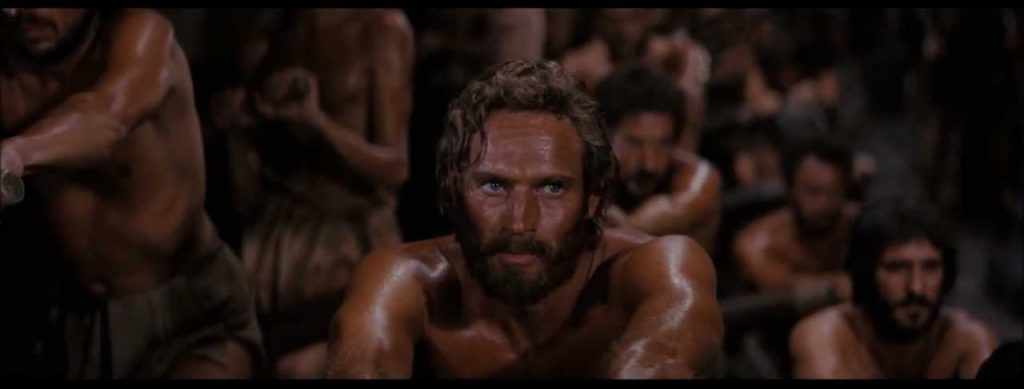“Ben-Hur” may seem like an odd choice to kick off our 5th annual Man Movie May, but I disagree. A film containing sword fights, a hi-seas battle with pirates, and a decade long quest for revenge fits perfectly. That it stars a chiseled and gritty tough guy like Charlton Heston only solidifies the selection.
“Ben-Hur” is a critically lauded piece; nominated for 12 Academy Awards and winning 11 – a record held for 37 years until tied by “Titanic,” and was chosen for preservation by the National Film Registry for being a “culturally, historically, or aesthetically significant” motion picture.
60 years after its release, it holds up as an excellent film, overcoming the handicaps of 1959 cinema and a well-crafted story. It appears old, but it’s not dated. The cinematography of Robert Surtees is remarkable considering the limitations of the technology. The benefit of no CGI makes it appear much more realistic. It’s as if you are watching a portal into the historical realm of biblical times.
Charlton Heston stars as Judah Ben-Hur, a wealthy upper classman who makes the ultimate journey from rags to riches, going from a nobleman to a slave rowing in the galleys of a Roman warship. Heston plays the part of Ben-Hur with his typical fervor, winning Best Actor for the performance, and is actually quite good in the role.
“Ben-Hur” is based off an 1880 novel by Lew Wallace, and carries with it such deep themes as faith, loyalty, honor, freedom, and retribution. Ben-Hur’s childhood best friend Messala (Stephen Boyd) delivers him a betrayal that belongs in the archives with “The Count of Monte Cristo” and “Gladiator.”

The backdrop of the Roman Empire is present, continuing its conquest and slaughtering all who stand in the way. “Either you help me or you oppose me.” Messala tells Ben-Hur after he refuses to side with Rome over his own people. “You have no other choice.” Whilst Heston won the award, Stephen Boyd is truly ruthless in his screen time as the power-hungry and envious Messala.
Director William Wyler doesn’t shy away from the graphic nature that may have been deemed too obscene for its time. Slaves marching in the desert with bleeding feet, physical abuse and torment from the Roman Soldiers, and the harrows of a Leper Colony are all included. The true grit saw Wyler win the award for Best Director, and it makes the film stand up so well over time.
“Ben-Hur” is memorable for a handful of iconic scenes, specifically the Chariot Race, which featured two additional directors, and several assistants (one being a young Sergio Leone). The largest film set ever built at that time was crafted; an arena covering 18 acres, and the film crew constructed 18 chariots – 900 pounds each – to use (along with 78 horses) for the scene which took nearly a year to complete.
Heston and Boyd took lessons in how to ride, and each performed most of their own stunts. “I will pray that you live until I return,” Ben-Hur threatens Messala after the betrayal, and with that we get one of the best showdowns of all time. It’s a remarkable scene and rightfully one of the best in the history of cinema.
My personal favorite scene is the oceanic battle between the Romans and their enemies. Slaves are forced to row at various speeds, with whips lashing across their backs when they get tired. The men are chained to the oars of the ship; if you lose the battle, you will drown. It puts us in the galleys with the enslaved captives, and the anxiety they face as the fighting begins.
The movie would be flawless if an hour were trimmed out, with a running time of 212 minutes being far too long. The memorable scenes like the water battle and the chariot race are spaced so far apart it’s as if you forget about the excitement as the overabundance of text from the novel gets in the way. While the story covers a wide breadth of time, it’s the only weakness present in the story. However, at 3 hours 32 minutes, it’s a glaring weakness.
There are many side characters introduced that extend the narrative, and solid supporting roles in the forms of Jack Hawkins as Quintus Arrius, the commander of the Roman Fleet, and Ben-Hur’s love interest Esther (Haya Harareet), but a more taut pace would prevent the need to watch the film in multiple sittings.
“Ben-Hur” is an epic tale that, despite the length, is still as great in 2019 as it was in 1959.